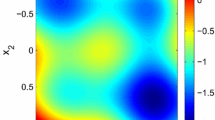Abstract
Let \(\Omega \) be an arbitrary set, equipped with an algebra \({\mathcal {A}}\subseteq 2^{\Omega }\) and let \(f: B({\mathcal {A}}) \rightarrow {\mathbb {R}}\) be a functional defined on the set \(B({\mathcal {A}}) \) of bounded measurable functions \(x:\Omega \rightarrow {\mathbb {R}}\). We provide necessary and sufficient conditions for a submodular functional f to be representable as a Choquet integral. From standard properties of the Choquet integral the functional f should be positively homogeneous and constant additive. Our first result shows that these two properties, together with submodularity, characterize a subadditive Choquet integral, when \(\Omega \) is finite. In the general case, f is a subadditive Choquet integral if and only if it satisfies the three previous properties, together with sup-norm continuity. This result provides another characterization of subadditive Choquet integrals different from the seminal paper by Schmeidler (Proc Am Math Soc 97(2):255–261, 1986) that relies on comonotonic additivity.
Similar content being viewed by others
Notes
The functional f is said to be comonotonic additive if \(f(x+y)= f(x)+f(y)\) for all x, y in \(B({\mathcal {A}}) \) such that \(x+y\in B({\mathcal {A}}) \) and \((x(\omega )-x(\omega '))(y(\omega )-y(\omega '))\ge 0\) for all \(\omega ,\omega '\) in \(\Omega \).
When \(\Omega \) is finite of cardinal n, we can identify \({\mathbb {R}}^{\Omega }\) with \({\mathbb {R}}^{n}\), thus a function \(x:\Omega \rightarrow {\mathbb {R}}\) can also be viewed as the n-tuple \(x=(x_{1}, \dots , x_{n})\). The previously defined order is the coordinate-wise order of \({\mathbb {R}}^{n}\), i.e., \(x=(x_{1}, \dots , x_{n})\le y=(y_{1}, \dots , y_{n})\) in \({\mathbb {R}}^{n}\) means \(x_{i}\le y_{i}\) for every \(i=1,\dots ,n\). The lattice operations \(\wedge \) and \(\vee \) are defined by \(x\wedge y:= (\min \{x_{1},y_{1}\}), \dots , \min \{x_{n},y_{n}\}), x\vee y:= (\max \{x_{1},y_{1}\}), \dots , \max \{x_{n},y_{n}\})\). With the previous identification, for \(A\subseteq \{1,\dots , n\}, \varvec{1}_{A}\) will now be the vector in \({\mathbb {R}}^{n}\) such that \(x_{i}=1\) if \(i\in A\) and \(x_{i}=0\) otherwise. Thus we denote by \(\varvec{1}_{i}:= \varvec{1}_{\{i\}}\) (resp. \(\varvec{1}_{\Omega }\)) the vector with all coordinates equal to zero, but the i-th equal to 1 (resp. with all coordinates equal to 1) so that \(x=(x_{1}, \dots , x_{n})= x_{1}\varvec{1}_{1}+ \dots +x_{n}\varvec{1}_{n}\).
This is easily proved to be equivalent to \(f(x +t \varvec{1}_{\Omega })= f(x) +t f(\varvec{1}_{\Omega })\) for all \(t\in {\mathbb {R}}\), all \(x\in {\mathbb {R}}^{\Omega }\). Also, under positive homogeneity, constant additivity is equivalent to
$$\begin{aligned} f(x + \varvec{1}_{\Omega })= f(x) + f(\varvec{1}_{\Omega }) \hbox { for all } x\in {\mathbb {R}}^{\Omega }. \end{aligned}$$Indeed, \(f(x +t \varvec{1}_{\Omega })= f(t(x/t + \varvec{1}_{\Omega }))= tf(x/t + \varvec{1}_{\Omega })=t(f(x/t) + f(\varvec{1}_{\Omega }))=f(x) +tf( \varvec{1}_{\Omega })\).
Under constant additivity, it is easily proved to be equivalent to f submodular on the whole space \({\mathbb {R}}^{\Omega }\).
Indeed \(bv({\mathcal {A}})\) contains the class of all finite games (i.e., \(\Omega \) is finite) since there are finitely many finite chains. Moreover, \(bv({\mathcal {A}})\) contains all capacities v since, using the monotonicity of v, for all finite chains \((A_{k}), \sum \nolimits _{k=1}^{K} |v(A_{k}) - v(A_{k-1}) |= \sum \nolimits _{k=1}^{K} v(A_{k}) - v(A_{k-1}) = v(\Omega ) -v(\emptyset ) = v(\Omega )\). Consequently, \(\Vert v\Vert = v(\Omega )<\infty \). An additive game \(\mu \) is called a charge (or a signed charge) and we point out that the total variation norm of a charge \(\Vert \mu \Vert \) is exactly the variation norm of the game \(\mu \) defined above.
As in Condition (i) of Theorem 2.2.
If f is additive, then the functional f is modular. Indeed, since \(x\vee y+ x \wedge y =x+y\): \(f(x\vee y) +f(x \wedge y) =f(x\vee y+ x \wedge y) =f(x+y)= f(x) +f(y)\) for all x, y in \(B({\mathcal {A}})\).
Define \( \Vert \mu \Vert =|\mu |(\Omega ):= \mu ^{+}(\Omega )+\mu ^{-}(\Omega )\), where \(\mu ^{+}(A):= \sup \{\mu (B) \, :\, B\subseteq A, A \in {\mathcal {A}}\}, \mu ^{-}(\Omega ):= -\inf \{\mu (B) \, :\, B\subseteq A, A \in {\mathcal {A}}\}\) for \(A \in {\mathcal {A}}\). Then \( \Vert \mu \Vert =|\mu |(\Omega )\) (see for example [3] Theorem 2.2.4 page 46, Theorem 4.1.2 page 86, [1] Corollary 10.53 page 397) and the result follows.
References
Aliprantis, C.D., Border, K.C.: Infinite Dimensional Analysis. Springer-Verlag, New York (1999)
Aumann, R., Shapley, L.: Values of Non-atomic Games. Princeton University Press, Princeton (1974)
Bhaskara Rao, K.P.S., Bhaskara Rao, M.: Theory of Charges, A Study of Finitely Additive Measures. Academic Press, New York (1983)
Choquet, G.: Theory of capacities. Annales de l’Institut Fourier 5, 131–295 (1954)
Dellacherie, C.: Quelques commentaires sur les prolongements de capacités. Séminaire Probabilités V. Lecture Notes in Math. 191. Springer-Verlag, New York (1971)
Denneberg, D.: Non-additive Measure and Integral. Kluwer, Dordrecht (1994)
Huber, P.J.: Robust Statistics. Wiley, Hoboken (1981). (Series in Probabilities and Mathematical Statistics)
König, H.: The (sub/super) additivity assertion of Choquet. Studia Math. 157, 171–197 (2003)
Marinacci, M., Montrucchio, L.: Introduction to the mathematics of ambiguity. In: Uncertainty in Economic Theory. Routledge, New York (2004)
Marinacci, M., Montrucchio, L.: On concavity and super modularity. J. Math. Anal. Appl. 344, 642–654 (2008)
Rockafellar, R.T.: Convex Analysis. Princeton University Press, Princeton (1970)
Schmeidler, D.: Integral representation without additivity. Proc. Am. Math. Soc. 97(2), 255–261 (1986)
Schmeidler, D.: Subjective probability and expected utility without additivity. Econometrica 57, 571–587 (1989)
Shapley, L.S.: Cores of convex games. Int. J. Game Theory 1, 12–26 (1971)
Topkis, D.: Supermodularity and Complementarity. Princeton, New Jersey (1998)
Author information
Authors and Affiliations
Corresponding author
Rights and permissions
About this article
Cite this article
Chateauneuf, A., Cornet, B. Choquet representability of submodular functions. Math. Program. 168, 615–629 (2018). https://doi.org/10.1007/s10107-016-1074-7
Received:
Accepted:
Published:
Issue Date:
DOI: https://doi.org/10.1007/s10107-016-1074-7



